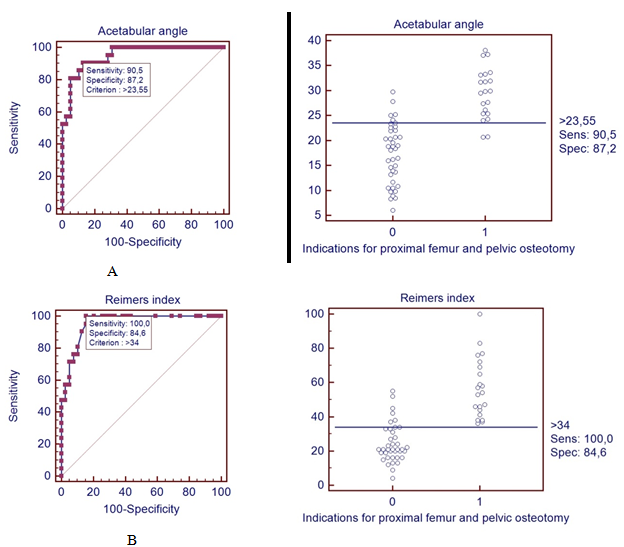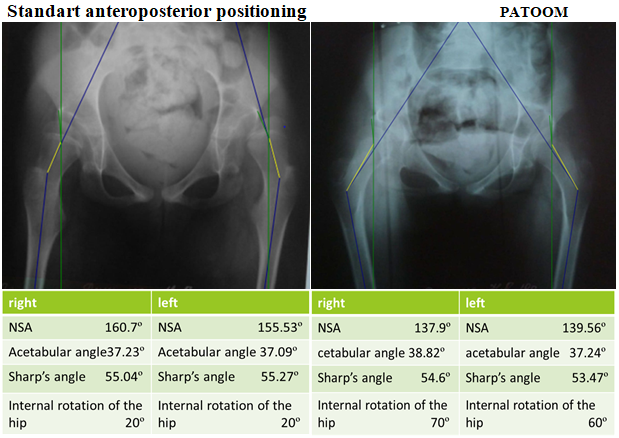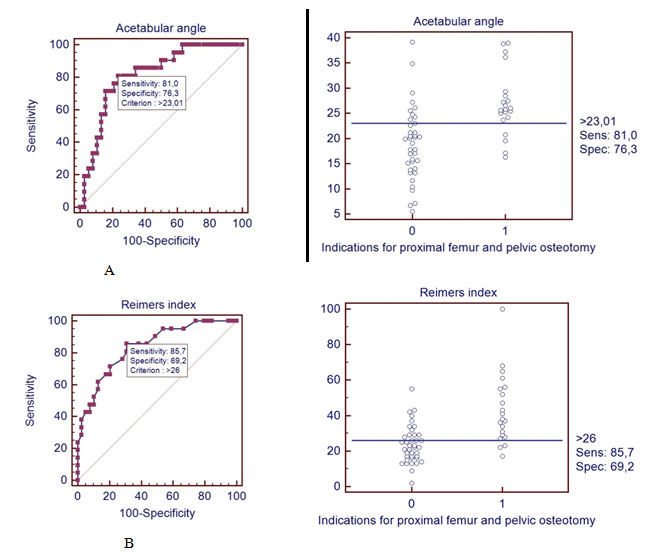MOJ
eISSN: 2374-6939


Research Article Volume 14 Issue 4
SI “Institute of Traumatology and Orthopedics of the National Academy of Medical Sciences of Ukraine”, Kyiv, Ukraine
Correspondence: Yatsuliak Mykhailo Bogdanovych, postgraduate student, SI “Institute of Traumatology and Orthopedics of NAMS of Ukraine”, 27 Bulvarno-Kudriavska St., Kyiv, 01061, Ukraine, Tel +38(097)2655377;
Received: May 20, 2022 | Published: July 8, 2022
Citation: Yatsuliak MB. Mathematical modeling of indications for pelvic and proximal femur osteotomy in patients with cerebral palsy based upon clinical and radiographic parameters of the hip joint. MOJ Orthop Rheumatol. 2022;14(4):92-95. DOI: 10.15406/mojor.2022.14.00585
Relevance. A differentiated approach to pelvic and proximal femur osteotomy in hip disease among patients with cerebral palsy is a relevant subject of study.
The aim of the study. Diagnostic improvement in diseases of the hip joints in cerebral palsy to create a differentiated approach to the reconstruction of the pelvis and proximal femur osteotomy based upon mathematical modeling.
Materials and methods. The total number of patients was 33 patients (60 joints). We conducted a clinical and radiographic examination of the hip joints using our own method and standard anterior-posterior radiographs, determining the parameters of the hip joint. Mathematical modeling of indications for proximal femur osteotomy and combination of pelvic and proximal femur osteotomy using logistic regression was also performed.
A mathematical model entitled "Probability of indications for pelvic and proximal femur osteotomy " based upon acetabular angle (AA), Reimers' index (RI), GMFCS level and ambulation for both positionings was developed.
We have offered a mathematical model for determining indications for pelvic and hip osteotomy in hip joint diseases among children with cerebral palsy for a standard anterior-posterior radiograph based upon AA, RI, GMFCS level and ambulation with a model accuracy 91.1%. The critical level of indicators in which indications for pelvic and proximal femur osteotomy are detected is for AA > 23.55 ̊, for RI > 34%.
Keywords: cerebral palsy, mathematical modeling, acetabular angle, Reimers' index
There is much debate among orthopedic surgeons regarding the fact which osteotomy better stabilizes the hip joint in patients with cerebral palsy (CP). When is it enough to perform proximal femur osteotomy, and when should it be combined with pelvic osteotomy? These issues are often addressed by the surgeon during surgery. Functional radiographs of the hip joints (HJ) due to limitation of hip abduction that is often observed among patients with cerebral palsy at the stage of examination in most cases can not be performed. Standard positionings do not yield true HJ parameters.
Over the last 4 years, we have managed to collect unique material from HJ radiological examinations in patients with cerebral palsy in the standard anterior-posterior positioning (SP) and in the positioning accordint to our own method (PATOOM).1 The true parameters of the HJ were obtained using PATOOM and it was also possible to assess how much the anatomical correpondences in the hip joint improve after the hip internal rotation. Sometimes we observed that the femoral subluxation was reduced in PATOOM.
The known true parameters of HJ, as well as changes of the Reimers index (RI) in the PATOOM, where the angle of hip internal rotation corresponds to the femoral torsion angle, determined clinically by Ruwe,2 gave us the opportunity to determine surgical treatment tactics. When we prepared a patient with cerebral palsy for surgery, we clearly knew who should perform a hip osteotomy and who should combine it with a pelvic osteotomy, as the HJ parameters on the radiograph with PATOOM were the same as after femoral derotation osteotomy. But we did not stop and decided to create two mathematical models (for both positionings) that can be used to determine the indications for the reconstruction of the femur. When the latter is combined with the reconstruction of the acetabulum, then based upon taken into account clinical and radiographometric parameters and factors the surgeon will make proper decision concerning surgical treatment.
The goal of the study is to improve the diagnosis of the hip joints diseases in cerebral palsy in order to create a differentiated approach to the reconstruction of the pelvis and proximal femur osteotomy based upon mathematical modeling.
In the SI "Institute of Traumatology and Orthopedics of the National Academy of Medical Sciences of Ukraine" for the period 2018-2022 we have been treated and analyzed clinical cases of 33 patients (60 joints) with the hip joints diseases in cerebral palsy. Previous researchers did not report significant differences between the sexes, so the patient's gender was not taken into account.3 No patient had a history of bone surgery. A mathematical model was developed and based upon the parameters of HJ: acetabular angle (AC) and Reimers' index (RI),4 and the next factors: ambulatory status (ambulating, non-ambulating) and the Gross Motor Function Classification System (GMFCS).5 The informativeness of other parameters (neck-shaft angle, femoral torsion, Sharpe angle, Viberg angle) that are taken into account when choosing therapeutic tactics was clarified. The age of patients ranged between 3-15 years. The sample in this study consisted mainly of patients with spastic tetraparesis (22 patients), spastic paraparesis (7 patients) and spastic hemiparesis (3 patients). Each hip joint was evaluated separately, in patients with hemiparesis only the affected side was taken into account. 20 of our patients were ambulating, and 12 patients were non-ambulating at the time of the examination, but were considered promising in terms of verticalization, or gait function was lost due to spastic hip dislocation.
All patients underwent: clinical evaluation of femoral torsion by Ruwe,2 standard anterior-posterior radiograph (SP) of HJ; posterior-anterior radiograph of the HJ according to PATOOM that yielded the true parameters.6 The lack of significant differences of AA (p> 0.05) defined in both positionings is described in our previous works.7
Statistical data processing was performed using statistical software STATISTICA 7.0, MedCalcStaticalSoftware v.11.5.0.0. using the χ² test, multiple logistic regression (calculating the odds ratio (OR) and 95% confidence interval (95% CI)) and ROC analysis with an estimate of the area under the curve (AUC)).
Depending on the type and nature of the data distribution, the appropriate statistical criterion was chosen to assess the reliability of the influence of the factor. For parameters that had a normal distribution, parametric methods of statistical evaluation were used. Discrepancies at significance level p <0.05 were considered significant.
In the study, the results of the analysis are presented in the form of distributions of clinical parameters (in %), arithmetic mean and standard deviation (M ± SD). Inter-group comparisons were performed using the Chi-square test and one-way analysis of variance (ANOVA) for the respective data types. Spearman's correlation coefficient was used to estimate the relationship between radiographometric parameters and other factors. To study the prognostic factors, multiple logistic regression was utilized using step-by-step exclusion of uninformative indicators to leave only significant independent variables in the final model. Critical value, sensitivity and specificity of the indicator were assessed using ROC analysis.
Most of the patients enrolled in this study had stable hip joints and were able to ambulate. We divided patients into those who underwent a round-validated proximal femur osteotomy and patients whom we on clinical round decided to perform a proximal femur osteotomy combined with a pelvic osteotomy (Pemberton or Degas operations, depending on age and structure of the acetabulum). Proximal femur osteotomies were performed at the intertrochanteric level and were usually derotatory, sometimes in combination with varisation and shortening. On control post-op radiographs in all cases one observed a normalization of the parameters of the hip joint.
To create a mathematical model, the HJ parameters were used, which are generally accepted and easy to calculate. Regarding factors, we separated ambulation according to the GMFCS, due to the lack of ambulatory function at the time of surgery in some patients with GMFCS levels II and III. The data were analyzed and refined and a good result was obtained. Models are designed for standard positioning and PATOOM.
Mathematical model of indications for pelvic and proximal femur osteotomy in patients with cerebral palsy (standard positioning):
Y - likelihood of indications for pelvic and proximal femur osteotomy
Y = 0.25 × АA + 0.13 × Reimers' Index – 1.18 × GMFCS + 0.03 × Ambulation – 7.7
Chi-square = 47.8, p < 0.001.
The accuracy of the model is 91.1%. Belonging to group 0 - "indications for proximal femur osteotomy" is determined by the model with an accuracy 94.4%, and belonging to group 1 - "indications for pelvic and proximal femur osteotomy" - with an accuracy 85.0%, area under the curve (AUC) = 0.965 (0.878 - 0.996), chi-square = 47.8, P <0.001. The model has a very good prognostic power, which indicates a good assessment of the probability of indications for pelvic and proximal femur osteotomy.
Mathematical model of indications for pelvic and proximal femur osteotomy in patients with cerebral palsy (PATOOM)
Y - likelihood of indications for pelvic and proximal femur osteotomy
Y = 0.08 × АA + 0.07 × Reimers' Index + 0.16 × GMFCS + 0.15 × Ambulation – 5.23
Chi-square = 23.8, p < 0.001.
The accuracy of the model is 74.6%. Belonging to group 0 - "indications for proximal femur osteotomy" is determined by the model with an accuracy 84.2%, and belonging to group 1 - "indications for pelvic and proximal femur osteotomy" - with an accuracy 57.1%, area under the curve (AUC) = 0.852 (0.736 - 0.996), chi-square = 23.8, P <0.001. The model has a very good prognostic power, which indicates a good assessment of the probability of indications for pelvic and proximal femur osteotomy.
The models were based upon data from 33 patients (60 joints), of them 39 (65%) joints had indications for proximal femur osteotomy, 21 (35%) had indications for pelvic and proximal femur osteotomy. Thirteen indicators were taken into account to find out which of them are the most informative and which are less informative. The most informative were: RI, AA, ambulation. However, as GMFCS adds 3% accuracy, it was decided to add it as well.
To create mathematical models, we studied clinical cases and used radiographs of patients who were referred to us for specialized care. Some patients were non-ambulating independently at the time of surgery. GMFCS IV was less common in older patients. Age was an uninformative factor, as problems with the hip joint can develop in early childhood and adolescence.
Our mathematical model proposed for a standard anteroposterior radiograph has a good accuracy – 91.1%. Model "Indications for proximal femur osteotomy" is determined with an accuracy 94.4%, and model "Indications for pelvic and proximal femur osteotomy" is determined with an accuracy 85.0%. In our opinion, this is due to the fact that pathological changes of the parameters of the proximal femur are observed in most patients with cerebral palsy, so in reconstructive surgery always one need to normalize the anatomical and functional state of the hip. Sometimes among patients with stable HJ but with excessive femoral torsion, we did not recommend reconstructive surgery in elderly patients due to the risk of ambulation loss, sometimes due to incorrect, inappropriate adductor myotomy. When making decision concerning pelvic osteotomy, we took into account the stability of the joint, as well as pathological parameters of the acetabulum relative to age norms.
There are likely to be other risk factors, such as the range of HJ motion, the degree of spasticity, and the subtypes of cerebral palsy that should be considered when deciding on the treatment of an individual child.8 The critical level of AA, at which were revealed indications for pelvic and proximal femur osteotomy was > 23.55º (Figure 1a), the critical level of the Reimers' index was > 34% (Figure 1b) for standard antero-posterior radiograph.

Figure 1 A,B ROC analysis to determine the prognostic value of indicators concerning the probability of indications for pelvic and proximal femur osteotomy in patients with CP. Critical level of parameters for the two groups ("Indications for proximal femur osteotomy" - 0; " Indications for pelvic and proximal femur osteotomy " - 1) is based upon: acetabular angle (A), Reimers' index (B). (Standard positioning).
The mathematical model for PATOOM has a good accuracy - 74.6%. In this case, model "Indications for proximal femur osteotomy" is determined with an accuracy 84.2%, and model "Indications for pelvic and proximal femur osteotomy" is determined with an accuracy 57.1%. In our opinion, the somewhat lower accuracy of this model is due to the fact that when performing the radiograph in this positioning with the help of internal femoral rotation, we center the femoral head in the acetabulum, helping to reduce subluxation if it is present, and accordingly improve the parameters that characterize the relationship between the proximal femur and the acetabulum. However, this positioning is very important because it yields us the true HJ parameters, so we can calculate the degree of correction of the neck-shaft angle and femoral torsion before surgery at the stage of primary examination (Figure 2).

Figure 2 A 10-year-old patient with cerebral palsy. The change of neck-shaft angle(NSA) depending on positioning. On a standard anteroposterior radiogram the NSA is projective, on the original positioning true. The indicators of the acetabulum have not undergone significant changes and are within the statistical error. This is important, because when we perform a standard anteroposterior radiogram, the patient lies on his back, and with the original positioning lies face down. The angle of internal rotation of the femur when we perform the radiogram by original positioning corresponds to the angle of femoral torsion determined clinically by Ruwe. Both radiographs of the child's hip joints were performed in one day.
The critical level of AA, at which we revealed indications for pelvic and proximal femur osteotomy was > 23.01º (Figure 3a), the critical level of the Reimers' index was > 26% (Figure 3b) for standard antero-posterior radiograph.

Figure 3 A,B ROC analysis to determine the prognostic value of indicators concerning the probability of indications for pelvic and proximal femur osteotomy in patients with CP. Critical level of parameters for the two groups ("Indications for proximal femur osteotomy" - 0; " Indications for pelvic and proximal femur osteotomy " - 1) is based upon: acetabular angle (A), Reimers' index (B). (PATOOM).
Early detection of HJ disease in cerebral palsy can be limited to proximal femur osteotomy, as pathological changes in the acetabulum appear later.9 We have developed our own system of clinical and radiographic screening of the hip joint among patients with cerebral palsy using mathematical modeling for early detection of pathologic changes.10 Particular attention should be paid to patients with cerebral palsy who have developmental hip dysplasia.11
Patients with mild cerebral palsy (GMFCS I) were not taked into account in this study because pathological changes in HJ here are very rare, the same was applicable to severe forms of cerebral palsy (GMFCS V) because in this case palliative surgery replaces reconstructive one.
Our model does not answer the question which pelvic osteotomy should be performed among patients with cerebral palsy, instead it makes possible to determine the range of surgery based upon the exact HJ parameters during the examination, but the final decision must be made individually for each child.
A mathematical model was offered for determining indications for pelvic and proximal femur osteotomy in hip joint diseases among children with cerebral palsy for a standard anterior-posterior radiograph based upon AA, RI, GMFCS and ambulation with a model accuracy 91.1%. The critical level of indicators at which indications for pelvic and proximal femur osteotomy are detected is for AA > 23.55 ̊, for RI > 34%.
The authors express their gratitude for the fruitful cooperation to friend, teacher and colleague V. Hoshko (08.04.1949–09.28.2020).
The authors state that there is no conflict of interest during the preparation of this article.

©2022 Yatsuliak. This is an open access article distributed under the terms of the, which permits unrestricted use, distribution, and build upon your work non-commercially.